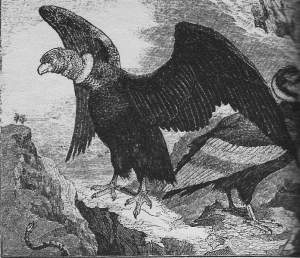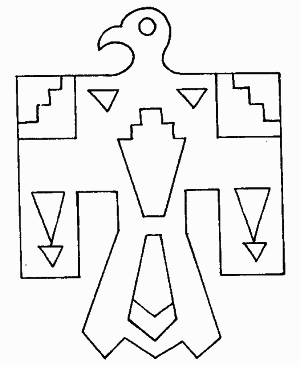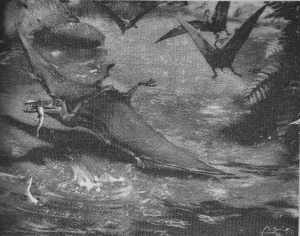Monsters You Never Heard Of (5 page)
Read Monsters You Never Heard Of Online
Authors: Daniel Cohen

Throughout the British Isles there is a tradition that graveyards were guarded by a spirit in the form of a black dog. Though the black dog was supposed to protect the souls of those buried in the graveyard from the Devil, it was considered extremely bad luck for any living person to see the dog. In fact, anyone who saw it was supposed to die within a year.
Several old English families are supposed to be cursed with a black dog. Whenever the dog appears, a member of the family dies.
As a rule, one would not care to meet one of these black dogs. But there are a few stories in which mysterious blacks dogs guarded travelers.
There was a tale told at the beginning of this century about a man named Johnnie Greenwood. One night he had to ride through a wood about a mile long to get to where he was going. At the entrance to the wood a large black dog joined him. It just trotted along by his side. He had no idea where it came from.
Even when it got so dark that he could no longer see the dog, Johnnie knew it was there because he could hear its footsteps. But when he came out of the woods the dog was gone.
That same night Johnnie returned the same way he had come. At the entrance to the wood the dog joined him again. As before, he didn't touch it or speak to it. When he got out of the woods the dog was once again gone.
Years later, two prisoners condemned to be hanged confessed that they had intended to rob and murder Johnnie that night in the wood. But when they saw the dog, they decided that both Johnnie and the dog would be too much to handle, so they left him alone.
As we have seen, phantom dogs can be dangerous, helpful, or just frightening. But no sane person would ever want to meet a whole pack of phantom hounds. For these would most likely be the feared creatures known as the Wish Hounds or the Devil's Dogs.
The Wish Hounds, or the Devil's Dogs, are part of one of the oldest and most persistent of all European legends the Wild Hunt. The legend runs like this: On certain nights a phantom huntsman, leading a pack of phantom hounds, can be heard, and sometimes seen, racing across the desolate countryside.
In one form or another this legend is told throughout Europe. Often the huntsman is said to be the Devil or some demon. Sometimes he is supposed to be a particularly evil person condemned to ride until Judgment Day without a rest. The dogs are usually described as being black with glowing red eyes. In some versions of the tale, however, the dogs are described as being headless.
According to the legend, anyone unlucky enough to see the Wild Hunt will be torn to pieces by the dogs or otherwise killed. Failing that, the unlucky soul is sure to die within a year.
Belief in the Wish Hounds remained strong until the end of the last century. In England in the 1870s a body was found on the banks of the River Yealm. An inquest was held to find the cause of death. When no obvious cause could be found, the jury wanted to say that the man was "struck down by the phantom hunt" or met "death by supernatural agency." With some difficulty the jury was persuaded to return a more ordinary verdict of "accidental death."
In recent years, belief in the Wild Hunt appears to have weakened. But up until the 1950s, at least, there were still people who said they could hear the barking and yelping of the phantom hounds on dark and stormy nights.
People didn't want to go out and see if the huntsman and his pack were really out there. They knew too many stories about what was supposed to have happened to those who did see the Wild Hunt.
But from time to time there was a story about someone who escaped the demon hunter and his phantom hounds.
About a century ago a tale of a poor but very lucky herdsman was told in the west of England.
The herdsman was riding home one night. In the distance he heard the baying of the Devil's Dogs. He knew he had several miles to go before he reached the safety of his home. He rode as fast as he could, but the phantom pack was gaining on him. When he turned around he could see them coming up behind him. The hunter had horns and a tail, just as the Devil is usually pictured. The dogs were black and snorted fire. The noise they made was horrible.
There was no shelter, no place where the herdsman could hide. Then suddenly he had a thought. He stopped his horse, jumped off and fell to his knees in prayer. The dogs that were just about to pounce on him held back, howling more loudly than ever. The demon hunter looked at him and said, "The boy prays." At that, they all turned off in pursuit of some other soul.
The American Indians have a legend about a creature called the Thunderbird. The Thunderbird is supposed to be gigantic. According to some legends, it could darken the entire sky as it flew by.
Most people think that the Thunderbird is completely a legend. It has been suggested that the idea of the Thunderbird was based on the condor. The condor is a very large vulture-like bird. It has a wingspan of from six to eight feet. The condor was once found throughout the American West. Today it is very rare. It lives only in the mountains of California. It is so rare that many scientists fear that it will soon become extinct. A somewhat larger condor lives in South America. But neither bird is anywhere near the size of the Thunderbird of Indian legend.

There are a few people who claim that the Thunderbird is more than a legend. They say that the stories are based on a gigantic, but unknown, bird. This bird may have existed until just a short time ago. And some think it may still exist today.
Unfortunately, the best piece of evidence for the existence of the Thunderbird has been lost. Perhaps it never even existed.
Here is the story. In 1886, a group of ranchers from Tombstone, Arizona, shot and killed a monster bird. They nailed it up, wings outstretched, on a barn. Then six men stood in front of the bird with their arms out, fingertips touching. This was to give some idea of the bird's size. Six average-sized men with outstretched arms would cover a distance of between thirty and thirty-six feet.

American Indian Thunderbird design
Now this astonishing scene is supposed to have been photographed. And the photograph was supposed to have been printed in the Tombstone newspaper. The paper had a very appropriate name, the Tombstone
Epitaph
. A lot of people say that they have seen the picture. The problem is that no one seems to be able to
find
it. A check of the files of the Tombstone
Epitaph
, which go back to about that time, reveal no trace of such a photograph.
One well-known monster hunter said that he had a copy of the original picture in his files. But he loaned it out, and it was never returned. To whom did he loan it? He couldn't remember.
There is another Big-Big Bird story from Tombstone that was supposed to have taken place at about the same time. It may be just another version of the original story. This time, however, the monster is winged, but has no feathers. It is supposed to have been smooth and hairless, its enormous jaws lined with razor-sharp teeth. The wings, which measured up to 160 feet, were thin membranes of skin. This creature was supposed to have been shot, or at least seen, in the Tombstone area around 1890.
The whole idea could be dismissed as just a wilder version of an already wild legend—except for one thing. This creature sounds more like one of the ancient flying reptiles called pterodactyls than it does like a bird. Pterodactyl-type creatures had the largest wingspread of any flying creature ever known. Actually, the pterodactyls probably didn't really fly. They would just glide along on air currents. They were very light, but their huge wings—30 or 40 feet from tip to tip—would keep them up in the air.

Some think the Thunderbird was some kind of giant flying reptile.
The trouble is that pterodactyls died out at about the same time the dinosaurs did—60 million years ago.
Giant bird stories come mainly from the American West. But there are a few interesting accounts from the East as well. In May, 1961, there was a report by the pilot of a private plane who was flying in New York State's Hudson Valley. He spotted what appeared to be another and slightly larger plane nearby. Suddenly this "plane" turned and tried to chase him. The pilot was surprised and frightened, but he circled back to try and get a closer look at the hostile plane. Then he noticed that the other "plane" was flapping its wings. It wasn't a plane at all; it was a gigantic bird. The pilot had seen enough. He flew off in a hurry.
There are frequent tales of planes crashing because of encounters with giant birds. There is no real evidence to support any of these romors, but the stories continue to exist.
Probably the most celebrated case took place in November, 1962. A United Airlines jet crashed in a wooded area of Maryland near Washington, D.C. There were no survivors in the crash. However, there were traces of blood and feathers found in the wreckage. Investigators decided that the plane must have run into a flock of birds shortly before it crashed. Perhaps the birds were even in some way responsible for the crash. Collisions with birds have been blamed for other plane crashes.
But some monster hunters noticed that scratches and gouges had been found on the tail assembly of the plane. They suggested that the plane had run into a Thunderbird. That angered the monster bird, which then turned and attacked the plane, sending it to its doom.
Why had the pilot not radioed information about his collision with a giant bird before the crash? Why had a bird of that size not been tracked on radar? Where is the monster bird hiding now? Questions like that have no answers.
Some monsters are reported frequently. They become legends. Other are seen only a few times. Then they seem to disappear. The Dover Demon was that sort of creature. But it certainly created enough excitement when it was reported.
The time was April 21 and 22, 1977. The place was the pretty town of Dover, Massachusetts, about fifteen miles southwest of Boston.
At about 10:30 in the evening of April 21, three seventeen-year-olds were out for a ride. Bill Bartlett was driving. Bill saw something creeping along a low wall at the side of the road. At first, he thought it was a cat. Then the headlights hit it and he got a good look.
The thing had a huge head with shining orange eyes. The rest of the body was small and skinny in comparison. It had long fingers and toes. The creature appeared to be hairless with a rough, peach-colored skin. He estimated that it would stand about four feet tall.
Bartlett only saw it for an instant, as the car lights flashed on it.
"Did you see that?" he yelled to the two passengers. The other two boys had been talking, and not looking out the window, so they didn't see a thing. But they wanted to. Bill was frightened, but the others persuaded him to drive back to the place where he had seen the thing. If it had ever been there, it was gone by the time they got back.
A little less than two hours later a fifteen-year-old named John Baxter was walking home. He saw a small figure coming down the street. He thought it was a friend of his who was quite short. He called out to the figure, but got no answer.
